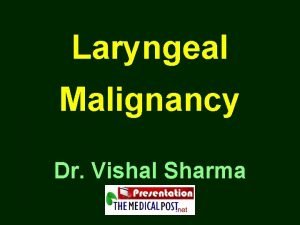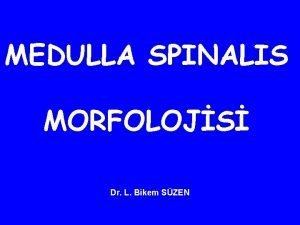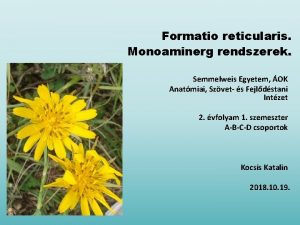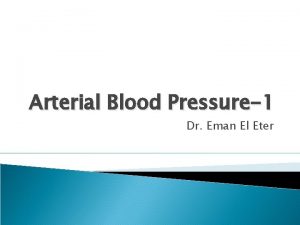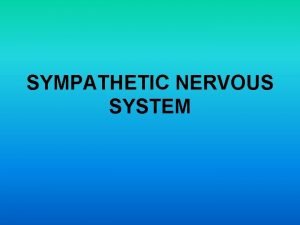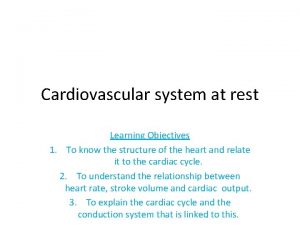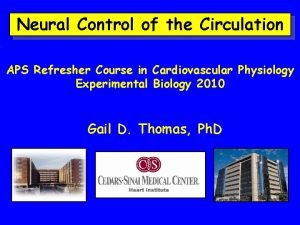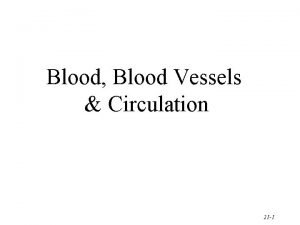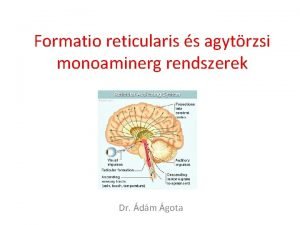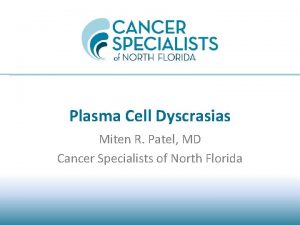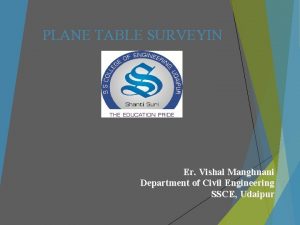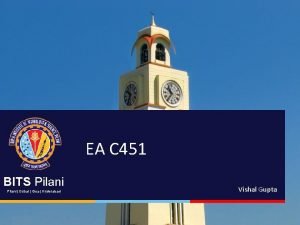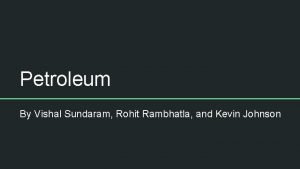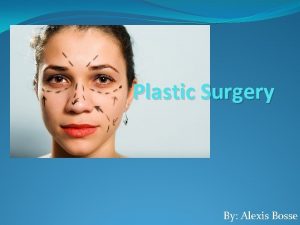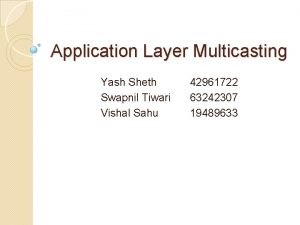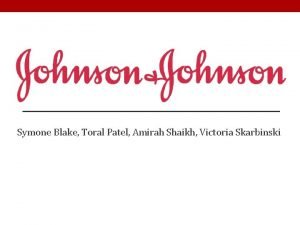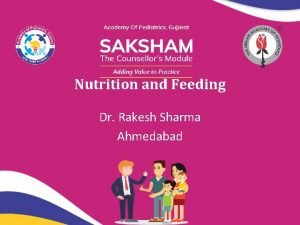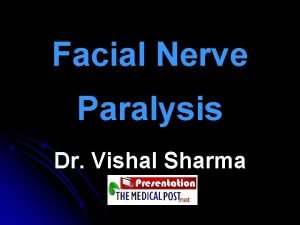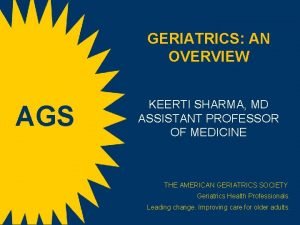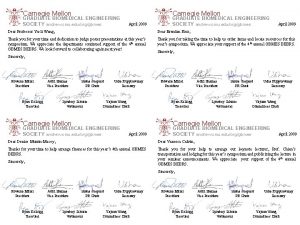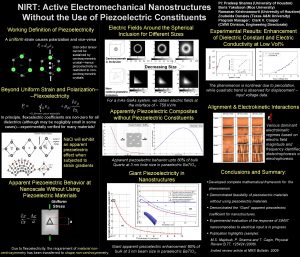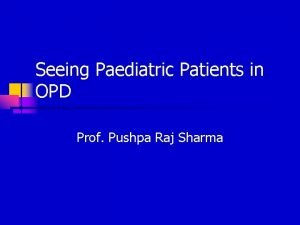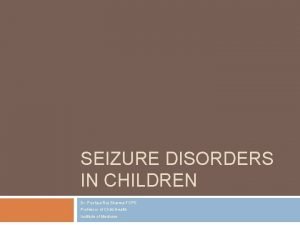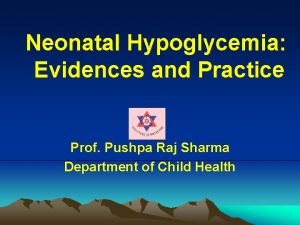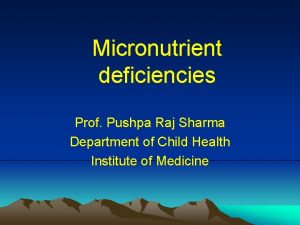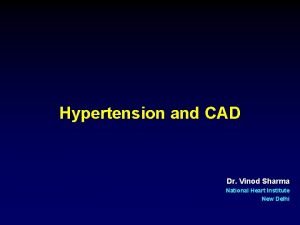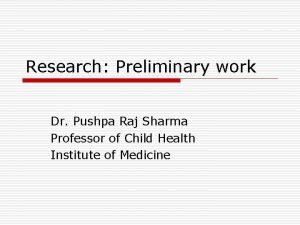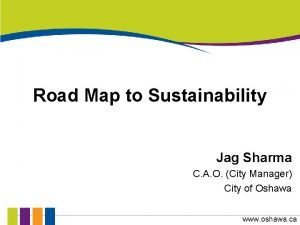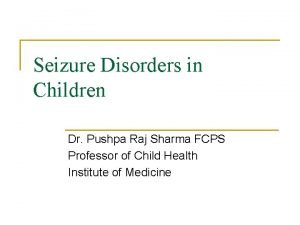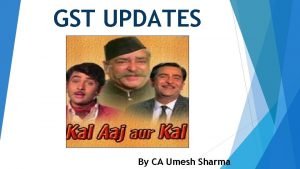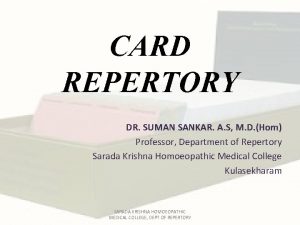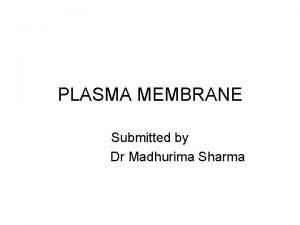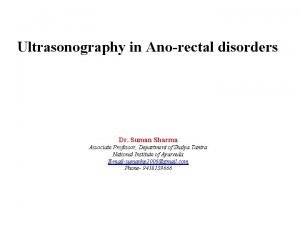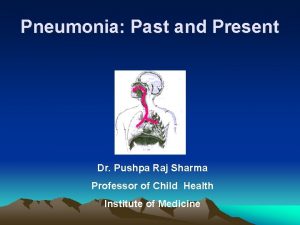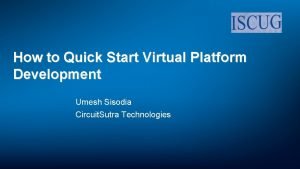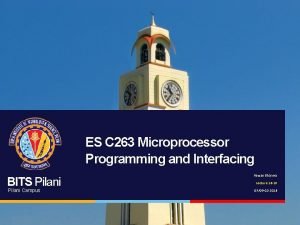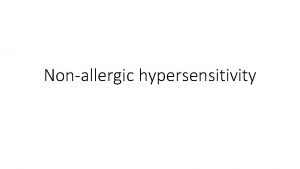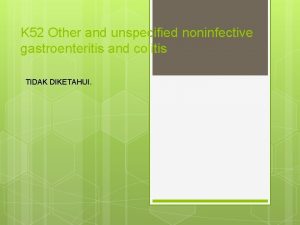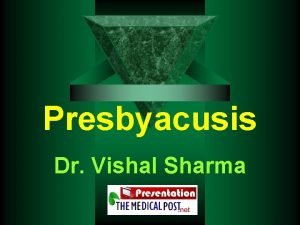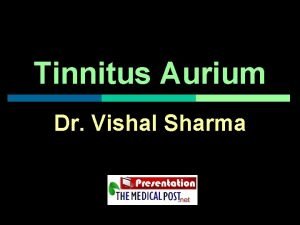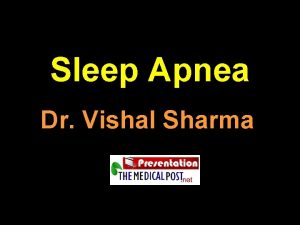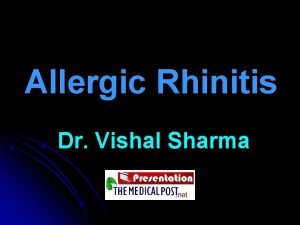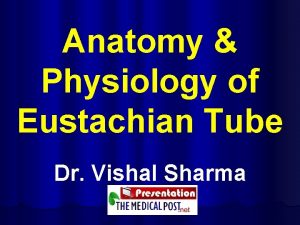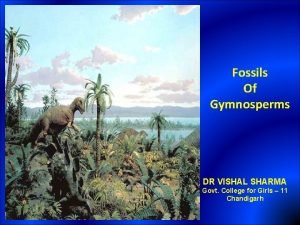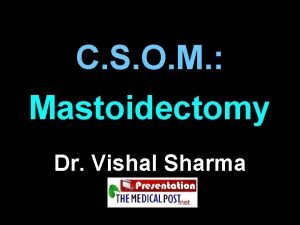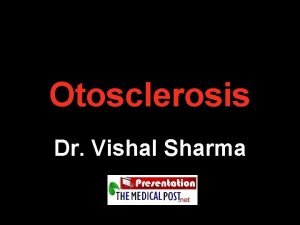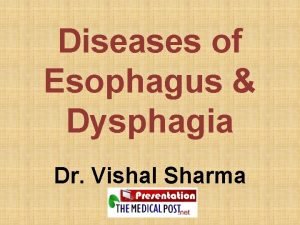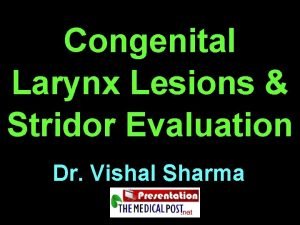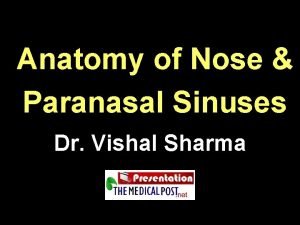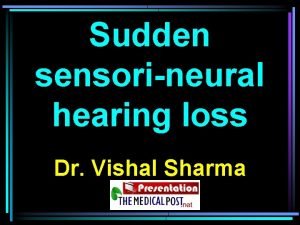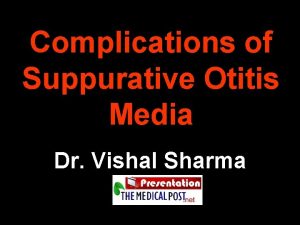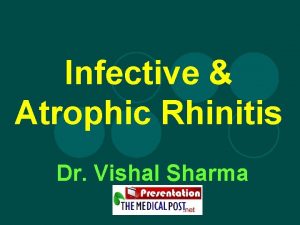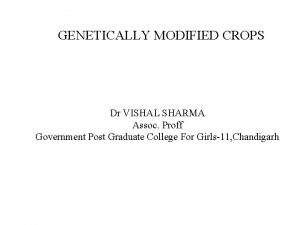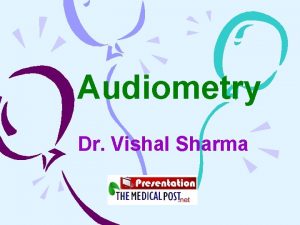Noninfective Nonallergic Rhintis Dr Vishal Sharma 1 Vasomotor

















































- Slides: 49

Non-infective Non-allergic Rhintis Dr. Vishal Sharma

1. Vasomotor rhinitis 2. Non-Allergic Rhinitis with Eosinophilia Syndrome 3. Occupational Irritant: flour, animal, wood, latex, paint 4. Rhinitis medicamentosa: decongestant nose drops 5. Drug-induced: propranolol, O. C. P. , amytriptilline 6. Endocrine: hypothyroid, pregnancy, menstruation 7. Addiction: alcohol, tobacco 8. Non-airflow: tracheostomy, laryngectomy 9. Miscellaneous: honeymoon / emotional

Autonomic Innervation of Nose • Deep petrosal nerve (Symp) + greater superficial petrosal nerve (Para-symp) vidian nerve pterygo-palatine ganglion nasal glands • Sympathetic stimulation vasoconstriction + ed nasal secretions • Para-sympathetic stimulation vasodilatation + ed nasal secretions

Vasomotor Rhinitis

Pathogenesis • Caused by over activity of para-sympathetic nervous system leading to: • nasal congestion (due to nasal vasodilatation) • nasal block (due to nasal vasodilatation) • watery rhinorrhoea (due to ed nasal secretion)

Trigger Factors 1. emotional stress (hypothalamus controls autonomic nervous system) 2. sudden change in temperature 3. humidity 4. blasts of cold air 5. dust 6. smoking & traffic fumes

Clinical Features Symptoms are perennial • Nasal block (Blockers) • Profuse watery rhinorrhoea (Runners) § Paroxysmal early morning sneezing § Post nasal drip § Turbinates congested & hypertrophied

Diagnostic Nasal Endoscopy

Sequelae & Differential Diagnosis Sequelae Nasal polyp Hypertrophic rhinitis Sinusitis Differential diagnosis • Allergic rhinitis • Non-allergic rhinitis with eosinophilia syndrome • Rhinitis medicamentosa

Allergic N. A. R. E. S. Vasomotor Allergen exposure Yes No No Nasal itch +++ + Minimal ed sneezing +++ + Minimal Nasal block ++ + Hyposmia ++ + Rhinorrhoea ++ ++ +++

Allergic N. A. R. E. S. Vasomotor Nasal mucosa Pale Congested Nasal polyps ++ ++ Rare Absolute Eosinophil Count ed Normal Nasal smear eosinophil ed Normal Skin prick test Positive Negative Treatment Steroid spray, Anti H 1, Ipratropium, Nasal decongestant Botulinum

Treatment of Vasomotor Rhinitis

General Measures Sleep with head end elevated by 30 0 Sleep + work in a cool environment (not cold) Keep body warm Regular exercise program to improve vasomotor tone Avoidance of trigger factors

Medical Treatment • Ipratropium bromide spray (0. 03%) • Intra-turbinal injection of Botulinum toxin • Steroid spray • Topical Cromolyn sodium (prophylaxis only) • Anti-histamines • Nasal decongestant

Drug Sneeze Rhinorrhoea Nasal Nose ed block itch smell Antihistamine +++ +++ 0 Steroid spray +++ +++ ++ + Cromoglycate + + 0 Topical nasal decongestant 0 0 ++++ 0 0 Ipratropium 0 ++ 0 0 0


Antihistamines Systemic: Cetirizine: 10 mg OD Fexofenadine: 120 mg OD Loratidine: 10 mg OD Levocetrizine: 5 mg OD Desloratidine: 5 mg OD Topical: Azelastine spray (0. 1%): 1 -2 puff BD

Systemic Antihistamines

Topical Antihistamine spray

Nasal Decongestants Systemic decongestants Phenylephrine Pseudoephedrine Topical decongestants Xylometazoline Oxymetazoline Saline

Anti-cold preparations Name Chlorpheniramine Decongestant Paracetamol COLDIN 4 mg Ps. E 60 mg 500 mg SINAREST 4 mg Ps. E 60 mg 500 mg DECOLD 4 mg Ph. E 7. 5 mg 500 mg SUPRIN 2 mg Ph. E 5 mg 500 mg Ps. E = Pseudoephedrine; Ph. E = Phenylephrine

Topical Decongestants • Oxymetazoline 0. 05 %: 2 -3 drops BD (NASIVION) • Oxymetazoline 0. 025 %: 2 drops BD (NASIVION-P) • Xylometazoline 0. 1 %: 3 drops TID (OTRIVIN) • Xylometazoline 0. 05 %: 2 drops BD (OTRIVIN-P) • Saline 2 %: 3 drops TID • Saline 0. 67 %: 2 drops BD (NASIVION-S)

Nasal Decongestants

Ipratropium nasal spray Has anti-cholinergic action

Botulinum Toxin Injection Inhibits release of Acetylcholine rhinorrhoea

Corticosteroid sprays Steroid Strength Acute attack Maintenance / puff dose Beclomethasone 50 g 2 puffs BD 1 puff OD Budesonide 64 g 2 puffs OD-BD 1 puff OD Fluticasone 50 g 2 puffs OD-BD 1 puff OD Mometasone 50 g 2 puffs OD-BD 1 puff OD

Corticosteroid nasal spray

Sodium Cromoglycate

Surgical Treatment 1. Measures which reduce size of nasal turbinates to relieve nasal obstruction 2. Sectioning parasympathetic secreto-motor fibers of nose (vidian neurectomy) to relieve excessive rhinorrhoea

Inferior Turbinate Surgeries

Surgeries for mucosal hypertrophy On surface: Electrocautery Laser vaporization Intramural: Electrocautery (SMD) Cryotherapy Radiofrequency ablation Surgeries for bony hypertrophy Submucous resection of inferior concha Surgeries for mucosal + bony hypertrophy Partial turbinectomy Total turbinectomy Inferior turbinoplasty (neo-turbinate)

Hypertrophied Turbinate

Submucosal diathermy

Radiofrequency ablation

Partial Turbinectomy

Total (Radical) Turbinectomy

Inferior Turbinoplasty

Vidian Neurectomy • Trans-antral approach (Golding Wood) • Trans-septal approach

Rhinitis Medicamentosa

Introduction • Rebound nasal congestion due to use of intranasal decongestants for > 7 days • With prolonged use, tachyphylaxis occurs, resulting in need for more frequent doses & shorter duration of action of these drugs • Nasal medications containing benzalkonium chloride cause more rebound congestion

Offending drugs 1. Oxymetazoline 2. Xylometazoline These drugs contract smooth muscle of venous erectile tissue, present in nasal turbinates, causing mucosal shrinkage & decreasing airway resistance

Pathogenesis


Clinical Features 1. Chronic nasal block requiring increased dose & frequency of topical decongestants 2. Watery rhinorrhoea usually absent, seen only in co-existing allergic or vasomotor rhinitis 3. Nasal mucosa appears hyperemic, granular & boggy in early stages 4. Later, it appears pale & anemic

Treatment • Immediate withdrawal of topical decongestant • Substitute with systemic nasal decongestants • Nasal corticosteroid sprays • Oral corticosteroids (for severe cases only) • Rhinostat system • Patient Education: Avoid topical decongestant use for > 7 days

Treatment For patients unable to stop topical decongestant immediately, stop nose drops in more patent nasal cavity & use it in other cavity for < 7 days Systemic decongestants used to relieve nasal block as pt is weaned off topical decongestants Phenylephrine & pseudoephedrine are used Corticosteroid spray used to local inflammation

Rhinostat System Consists of 2 bottles. First contains pt’s nasal decongestant spray, second has saline solution. Two solutions precisely combined for dosage dilution @ 15% / day. Dosage titration allows gradual withdrawal from decongestants while maintaining nasal inspiratory flow. Takes 3 -6 weeks days for complete withdrawal.

Rhinostat System

Thank You
 Camcer
Camcer Cornu anterior
Cornu anterior Monoaminerg
Monoaminerg Baroreceptor reflex
Baroreceptor reflex Vasomotor reversal of dale
Vasomotor reversal of dale Vasomotor center
Vasomotor center Vasomotor center
Vasomotor center Blood vessels
Blood vessels Vasomotor area
Vasomotor area Dr vishal jaiswal
Dr vishal jaiswal Principle of surveying
Principle of surveying Waldenstrom's
Waldenstrom's Simple alidade
Simple alidade Vishal gupta bits pilani
Vishal gupta bits pilani Vishal sundaram
Vishal sundaram Vishal thakkar nose
Vishal thakkar nose Link tree vishal tiwari
Link tree vishal tiwari Style
Style Vishal patel novartis
Vishal patel novartis Gaurav sharma cisco
Gaurav sharma cisco Dr rakesh sharma ahmedabad
Dr rakesh sharma ahmedabad Modern concept of pediatric nursing slideshare
Modern concept of pediatric nursing slideshare Gabriel sharma
Gabriel sharma Keerti sharma md
Keerti sharma md Rowena mittal
Rowena mittal Riju sharma
Riju sharma Pradeep sharma university of houston
Pradeep sharma university of houston Pushpa
Pushpa Pushpa raj sharma
Pushpa raj sharma Dr pushpa raj sharma clinic
Dr pushpa raj sharma clinic Dr vivek sharma
Dr vivek sharma Dr pushpa raj sharma
Dr pushpa raj sharma Ranipril
Ranipril Amrit sharma morgan stanley
Amrit sharma morgan stanley Dr pushpa raj sharma
Dr pushpa raj sharma Jag sharma
Jag sharma Hina sharma architect
Hina sharma architect Dr pushpa raj sharma contact number
Dr pushpa raj sharma contact number Ca umesh sharma
Ca umesh sharma Dr archana sharma psychologist
Dr archana sharma psychologist Card repertory model
Card repertory model Adjacency matrix of multigraph
Adjacency matrix of multigraph Madhurima sharma
Madhurima sharma Dr suman sharma
Dr suman sharma Lasert tag
Lasert tag Pushpa raj sharma
Pushpa raj sharma Umesh sharma md
Umesh sharma md Cs deepak sharma
Cs deepak sharma Pawan sharma bits pilani
Pawan sharma bits pilani Pushpa raj sharma
Pushpa raj sharma
